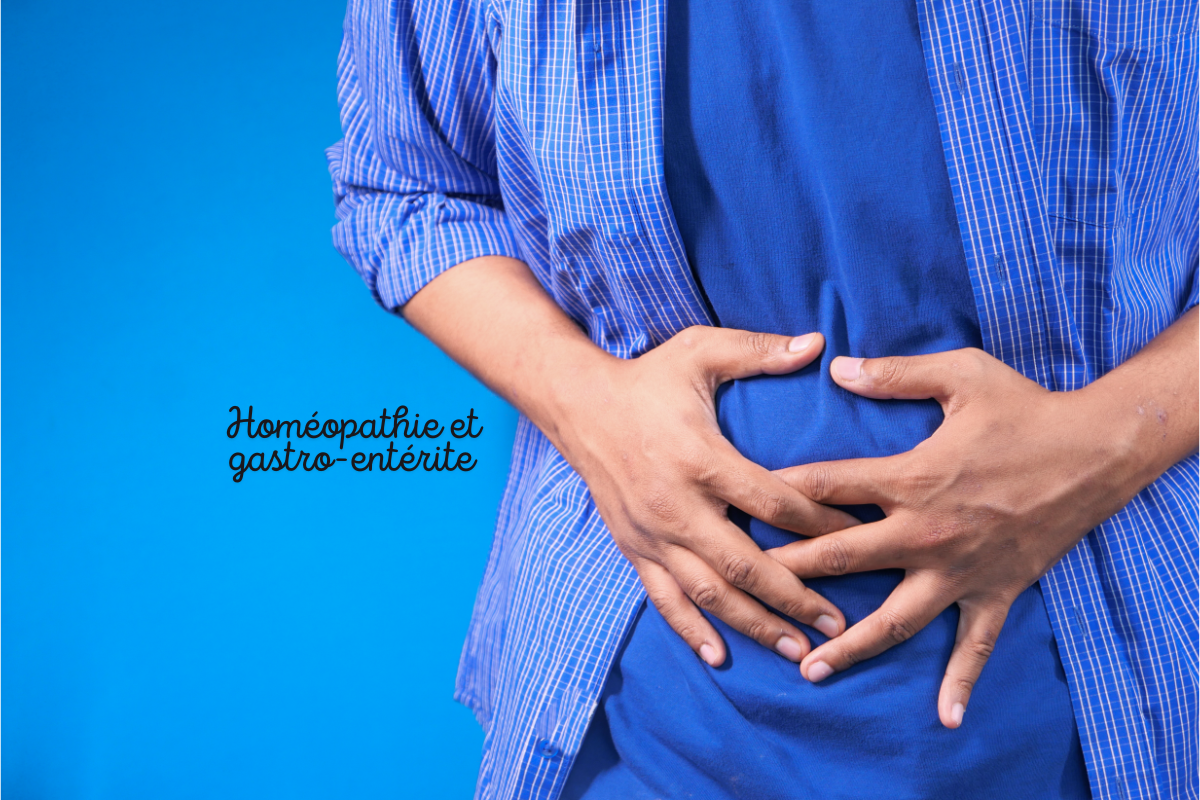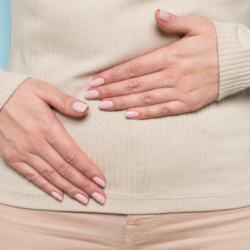Acute gastroenteritis is clinically characterised by a combination of vomiting and diarrhoea. Vomiting is the sudden release of gastric contents by antiperistaltic contractions. Diarrhoea is the frequent evacuation of excessively liquid stools.
Diarrhoea is caused by two mechanisms, most often in combination:
- Acceleration of intestinal transit
- Abnormal hydration of stools due to hypersecretion of the intestinal mucosa
These mechanisms are the direct consequences of an attack on the digestive mucosa.
Acute gastroenteritis is not a stand-alone, nosologically defined disease. They are merely reactionary syndromes that can be observed in an often complex clinical picture, resulting from a variety of causes:
- Various food poisoning infections
- Seasonal digestive disorders
- Infectious diseases (typhoid, cholera, influenza, otitis, etc.)
Diarrhoea and vomiting may or may not be associated, and may be responsible for metabolic disorders if they are abundant. Given the digestive tropism of the toxicology of many pharmacodynamic substances, the number of homeopathic medicines is particularly high.
For didactic reasons, we propose in this article to distinguish 5 different cases.
Isolated acute gastroenteritis
The patient presents with diarrhoea, vomiting or a combination of diarrhoea and vomiting, with the possibility of abdominal pain of varying intensity.
Diarrhoea predominates:
The choice of drug can quickly be guided by the characteristic features of this diarrhoea.
-
Abundant diarrhoea :
→ Podophyllum peltatum:
The diarrhoea is watery or mucous, very abundant, preceded by pain and borborygms. It occurs especially early in the morning or before midday. The stools are fetid, yellowish, expelled in a jet, followed by tenesmus, extreme weakness and a feeling of emptiness in the abdomen. The pain improves with warmth and lying on the stomach.
Dosage: Take 5 granules of Podophyllum after each bowel movement, at least 9 CH, as low dilutions may aggravate diarrhoea.
→ Aloe socotrina:
The diarrhoea is abundant, frequently mucous like jelly, accompanied by abundant intestinal gas which the patient dares not emit because of great sphincter insecurity. A bowel movement may occur immediately after drinking.
Posology: Take Aloe socotrina 7 CH or 9 CH, 5 granules after each bowel movement.
-
Painful diarrhoea :
→ Magnesia phosphorica:
This homeopathic medicine is indicated when diarrhoea is accompanied by crampy, acute pain with a sudden onset and end. Improvement is observed by being bent in half, by heat and by strong pressure.
Dosage: Take 7 or 9 CH, according to the rhythm of pain and/or bowel movements.
→ Colocynthis:
As magnesia phosphate is one of the pharmacodynamic constituents of coloquinte, Magnesia phosphorica and Colocynthis can be used interchangeably.
→ Cuprum metallicum and Cuprum sulfuricum:
In experiments, copper causes gastroenteritis with spasmodic manifestations in both smooth and striated muscles. Copper sulphate proves to be a powerful laxative. In homeopathic therapy, these medicines are taken for violent diarrhoea accompanied by cramp-like pain throughout the abdomen and even in the calves. The pain begins and ends abruptly. The patient may also experience very violent, intermittent stomach cramps, with nausea and vomiting, temporarily improved by drinking one or more sips of cold water.
Dosage: Take 5 x 7 or 9 CH granules at the same time as bowel movements and/or painful cramps.
-
Painless diarrhoea :
→ China rubra:
This medicine is taken when there is distension of the entire abdomen (which the patient seems to contain with hands), with great flatulence, tympany on percussion, as well as hypersensitivity to contact or touch. Stools are painless, but accompanied by a lipothymic sensation. Everything tastes bitter. This medicine is indicated after fruit or milk abuse (and also for diarrhoea in infants due to gluten intolerance).
Recommended dosage: Take China 7 or 9 CH after each bowel movement.
→ Ricinus communis:
Aqueous, whitish diarrhoea with a riziform tendency. Emission of stools is painless, preceded by painless borborygms accompanied by numerous nauseas.
Dosage: Take Ricinus communis 7 or 9 CH after each bowel movement.
-
Excoriating diarrhoea for the anus :
→ Croton tiglium:
Croton’s diarrhoea meets 4 very specific characteristics; it is excoriating for the anus and perianal region, liquid and yellow, expelled in a jet with a rattling sound, like that of a rifle shot and caused by indigestion of the slightest amount of food or drink.
This is often seen in diarrhoea occurring during antibiotic therapy.
Dosage: Take 5 x 7 or 9 CH granules of Croton tiglium at the same time as the stools.
→ Arsenicum album:
Burning abdominal pain, soothed by local heat accompanies liquid, blackish diarrhoea, burning the anus, with a nauseating odour.
Posology: take 5 granules of Arnsenicum album in 7 or 9 CH at the rate of the stools.
-
Motor diarrhoea :
This is the indication for Gelsemium sempervirens orArgentum nitricum.
Vomiting predominates:
In most cases this is indigestion due to overeating or acute alcoholism.
Nux vomica :
Containing strychnine and brucine, which are experimentally responsible for antiperistaltic spasms, this medicine is used in cases of nausea, regurgitation and acid vomiting, which are relieving, following overeating or drinking.
Dosage: Take 5 granules of Nux vomica 7 or 9 CH at the same time as the nausea. It should be noted that taking 5 granules or a tube-dose of this medicine as a preventive measure before indulging in the “Bacchus cult” facilitates digestion, reduces the feeling of drunkenness and avoids the unpleasant “hangover” sensation the next morning.
Antimonium crudum :
This medicine is used in the presence of eructations with the taste of food in individuals complaining of sensations of gastric fullness and heaviness, following the gluttonous absorption of too much food. The tongue is often heavily swollen, covered with a thick, milky-white coating. Nausea soon follows, followed by vomiting containing food debris. The stools are half-solid, half-liquid.
Dosage: Take 5 granules of Antimonium crudum 7 or 9 CH at the same rate as the nausea. It should be noted that taking 5 granules or a tube-dose of this medicine as a preventive measure before indulging in the Bacchus cult helps digestion, reduces the feeling of drunkenness and avoids the unpleasant feeling of a hangover the next morning.
Ipeca :
Here the patient presents with vomiting which does not relieve perpetual nausea. The tongue is clean or not very full, always kept moist by hypersalivation. The patient is not thirsty. Stools are accompanied by tenesmus. They may be fermented, green, frothy and sometimes bloody.
Dosage: 5 granules of Ipeca 7 or 9 CH, repeated more frequently the more intense the symptoms.
Acute febrile gastro-enteritis
Acute febrile gastroenteritis includes food poisoning and “intestinal flu”.
Aconitum napellus :
After a sudden chill, infants, children and adults develop green diarrhoea, sometimes with bloody mucus. Hyperthermia also sets in suddenly. The patient does not perspire, is agitated, anxious and thirsty for cold water.
Posology: Take 5 granules of Aconitum napellus 7 or 9 CH after each bowel movement.
Arsenicum album :
Burning abdominal pains, soothed by local heat, accompany liquid, blackish diarrhoea, burning the anus, with a nauseating, exhausting smell. There is also burning vomiting and a thirst for cold water, which is soon rejected. This picture evolves in an acute febrile context, with chills and alternating phases of agitation and prostration. The symptoms worsen at night, between 1am and 3am. Most of the time, these symptoms occur in the context of toxi-infectious syndromes, and Arsenicum album is an excellent remedy for poisoning caused by spoiled food (spoiled fish or meat, contaminated shellfish, polluted water).
Dosage: Take 7 or 9 CH, 5 granules repeated every hour, gradually spaced out as symptoms diminish. This medicine works quickly.
Baptisia :
- Febrile state with great prostration and mental confusion.
- Fetid, exhausting diarrhoea.
- Tympany and sensitivity of the right iliac fossa.
- Very foul breath and parchment-like tongue.
Dulcamara :
Preceded by borborygmas and periumbilical pain, calmed by the emission of gas, the diarrhoea is dysenteriform, either aqueous, with mucus sometimes bloody, or mucous, viscous, green or yellowish. It usually occurs in the context of a subacute fever with chills, after cooling down in damp weather.
Dosage: Take 7 or 9 CH, 5 granules repeated every hour, gradually spaced out as symptoms diminish. This homeopathic medicine acts quickly.
Mercurius solubilis :
This medicine is suitable when the stools are greenish, bloody or viscous, worse at night with tenesmus and the impression that the stools are never finished. Above all, the intestinal condition is concomitant with oral-pharyngeal and general signs characteristic of Mercurius solubilis :
- Fetid, metallic-smelling breath that spreads throughout the room.
- Tongue flaccid, swollen, retaining the lateral imprint of the teeth, covered with a yellowish-white coating, viscous due to exaggerated salivation which drips at night onto the pillow without diminishing the intense thirst.
- The fever is high and stable, accompanied by shivering and sweating, especially at night, which does not relieve the pain.
Posology: Take Mercurius solubilis 7 or 9 CH, 5 granules repeated every hour, gradually spaced out as the symptoms diminish. This medicine works quickly.
Mercurius corrosivus :
This medicine is very similar to Mercurius solubilis. It is preferred in acute dysentery, with a tenesmus even more painful than in the previous description. The stools are small, burning, bloody or bloody, with mucous debris and violent intestinal slices.
Dosage: Take 7 or 9 CH, 5 granules repeated every hour, gradually spaced out as the symptoms diminish. This medicine works quickly.
Acute gastro-enteritis with dehydration
Severe choleraform diarrhoea leads to dehydration and a deterioration in general condition. There are 3 successive stages:
- First, profuse stools are passed, leading to a leakage of water and electrolytes.
- Then, as the stools become rarer, the patient becomes weaker and the pain increases.
- Finally, when the patient can no longer eliminate, cramp-like pain develops.
These 3 phases correspond to 3 specific homeopathic medicines, which can be used separately or in turn, allowing us to observe the recovery of worrying situations. If the case so requires, the homeopathic treatment should be accompanied by parenteral rehydration and correction of electrolyte disorders.
Veratrum album :
This medicine is indicated in cases of febrile profuse diarrhoea, extremely abundant, with crampy pains, great prostration and abundant cold sweats especially on the forehead. Associated vomiting is often abundant and aggravates the tendency to collapse. The patient experiences an intense burning sensation with general coldness all over the body and cyanosis of the extremities.
Dosage: Take 5 granules of Veratrum album 7 or 9 CH, repeated every hour or at the same time as the bowel movements, then gradually spaced out as the intensity of the symptoms diminishes.
Arsenicum album :
This medicine is indicated when the stools, which burn like fire, excoriate the anus and are nauseating, become scanty. It is often associated with burning vomiting from the little food the patient absorbs. Febrile, thirsty and very weak, the patient alternates between restlessness, anxiety and depression. Symptoms flare up at night, between 1 and 3 in the morning.
Dosage: Take 5 granules of Arsenicum album 7 or 9 CH, repeated every hour or at the same time as the bowel movements, then gradually spaced out as the intensity of the symptoms diminishes.
Cuprum metallicum :
The patient now presents cramp-like pains throughout the abdomen and even in the calves, with a sudden onset and end, which are temporarily soothed by drinking a little cold water.
Dosage: Take 5 granules of Cuprum metallicum 7 or 9 CH, repeated every hour or at the same time as the bowel movements, then gradually spaced out as the intensity of the symptoms diminishes.
Acute gastro-enteritis in infants
A number of medicines are particularly suitable for use in infants. They are prescribed in particular circumstances: teething troubles, milk intolerance, acute febrile gastroenteritis. Homeopathic medicines for toxicoses can be confused with those studied for acute gastroenteritis with dehydration.
Acute gastroenteritis concomitant with dental flare-ups:
-
Chamomilla vulgaris :
In addition to diarrhoea and teething, the baby is temperamental, angry and hateful, and only calms down if carried, rocked in the arms or taken for a ride in the car. Diarrhoea is as green as spinach mixed with scrambled eggs. In the case of fever, one cheek is red and hot, while the other is pale and cold.
Dosage: Because of the change in the infant’s usual behaviour, take 5 Chamomilla 9 or 15 CH granules, repeated at the same time as painful bowel movements or fits of anger.
-
Rheum officinale :
The rhizome of rhubarb has been shown to cause intestinal hypersecretion. It is used in homeopathic therapy in infants who are teething, fussy and restless, with profuse sweating of the scalp and a sour odour despite all the care taken to keep them clean. Another therapeutic indication: diarrhoea following excessive ingestion of green fruit.
Dosage: Take 5 granules of Rheum officinale 7 or 9 CH with each bowel movement.
-
Mercurius solubilis :
In infants, this homeopathic medicine is used particularly at teething time when a febrile syndrome, diarrhoea and hypersialorrhoea are observed.
Dosage: Take 7 or 9 CH, 5 granules 2 to 4 times per 24 hours.
Acute gastro-enteritis due to milk intolerance :
-
Magnesia carbonica :
This is the medicine for infants who give off a sour smell all over their body and have a poor tolerance of milk. The diarrhoea is watery, foamy green, like frog spawn, with a sour smell.
Dosage: Take in 7 or 9 CH according to the frequency of bowel movements.
Acute febrile gastro-enteritis :
Febrile gastroenteritis in infants, apparently isolated, is very often accompanied by otitis. In this case, homeopathic therapy is based on a range of pharmacodynamic substances whose pathogenesis targets the digestive and ENT systems: Aconitum, Chamomilla, Arsenicum album, Belladonna, Capsicum, Dulcamara, Mercurius solubilis.
Medicines for convalescence from acute gastroenteritis
Acute gastroenteritis is an episode which, once the acute attack of digestive disorders is over, often leaves two types of more or less temporary after-effects:
- Physical asthenia
- Persistent loose stools or diarrhoea at the slightest dietary change
Persistent asthenia :
-
China rubra :
This medicine corresponds to the physical asthenia with pallor and hypotension seen in patients who have, in particular, experienced an abundant loss of body fluids.
Recommended dosage: Take 5 granules of China 7 or 9 CH twice a day until symptoms disappear, generally about ten days.
-
Natrum muriaticum :
For infants and young children who often suffer from severe asthenia and weight loss after episodes of diarrhoea.
Dosage: China rubra is well complemented by taking 1 to 2 weekly doses of Natrum muriaticum 9 or 15 CH until the initial weight is restored.
Persistent loose stools :
-
Paratyphoidinum B and Eberthinum :
These are biotherapics prepared from lysates of the corresponding salmonella cultures, without the addition of antiseptics. These 2 drugs may be indicated either on the basis of an aetiological diagnosis, or on the clinical diagnosis of persistent loose stools following acute gastroenteritis. In pathology, and therefore experimentally, these germs are responsible for irritation of the intestinal tract with diarrhoea.
Dosage: Take 1 dose per week in 9 or 15 CH until symptoms improve.
For each case, the study is limited to the most reliable and most frequently encountered medicines. It is always advisable to take medium or high dilutions in order to dry up secretions.
Steps to take to prevent gastroenteritis
- Wash your hands regularly: One of the most important ways to prevent gastroenteritis is to wash your hands regularly. Make sure you wash your hands before eating, after using the toilet, after changing a nappy, and after touching public surfaces.
- Avoid touching your face: Hands are often carriers of germs. Avoid touching your face as much as possible, especially your nose, eyes and mouth.
- Prepare your food properly: To avoid gastroenteritis, it’s important to cook meat and eggs thoroughly, wash fruit and vegetables and don’t leave food at room temperature for more than two hours.
- Avoid raw foods: Avoid eating raw foods such as raw eggs, raw meat and raw seafood. These foods can contain germs that can cause gastroenteritis.
- Avoid out-of-date foods: Avoid eating foods that have passed their expiry date. These foods can be contaminated and cause gastroenteritis.
- Avoid public places during an epidemic: If a gastroenteritis epidemic is underway, avoid public places such as schools, hospitals and restaurants as much as possible.
- Clean surfaces frequently: Clean surfaces frequently with a household cleaner to kill germs and bacteria.
- Avoid sharing utensils: Avoid sharing utensils such as forks, knives and spoons. This can spread germs and bacteria







